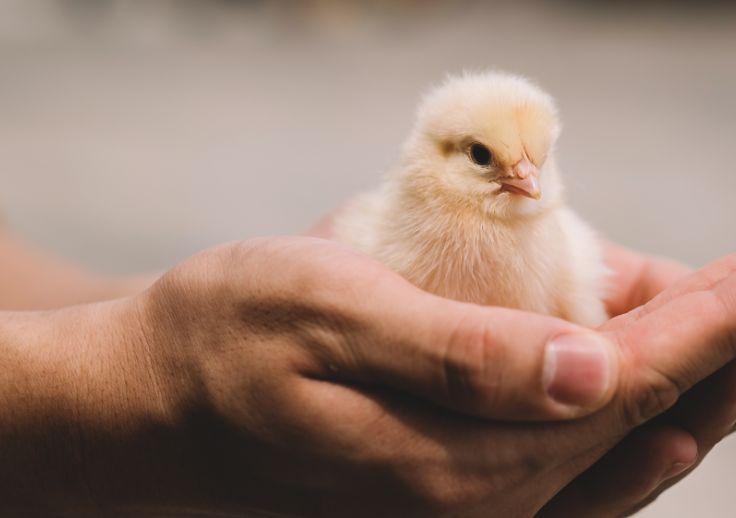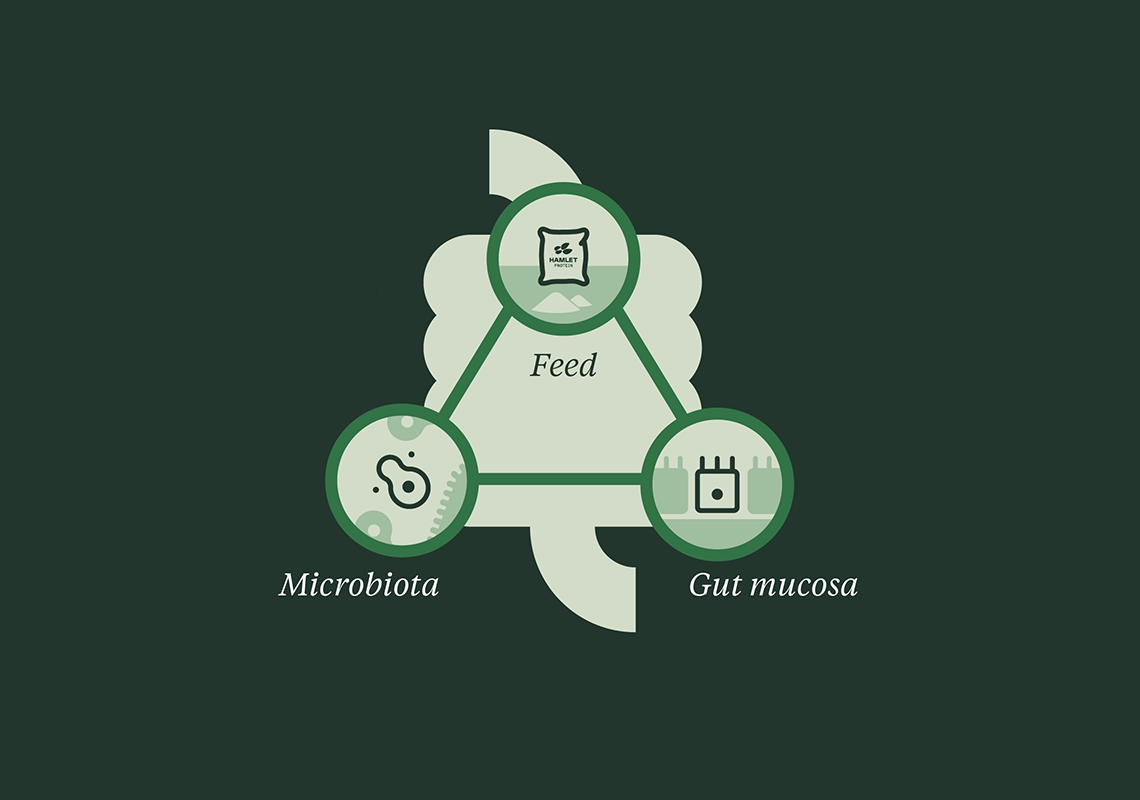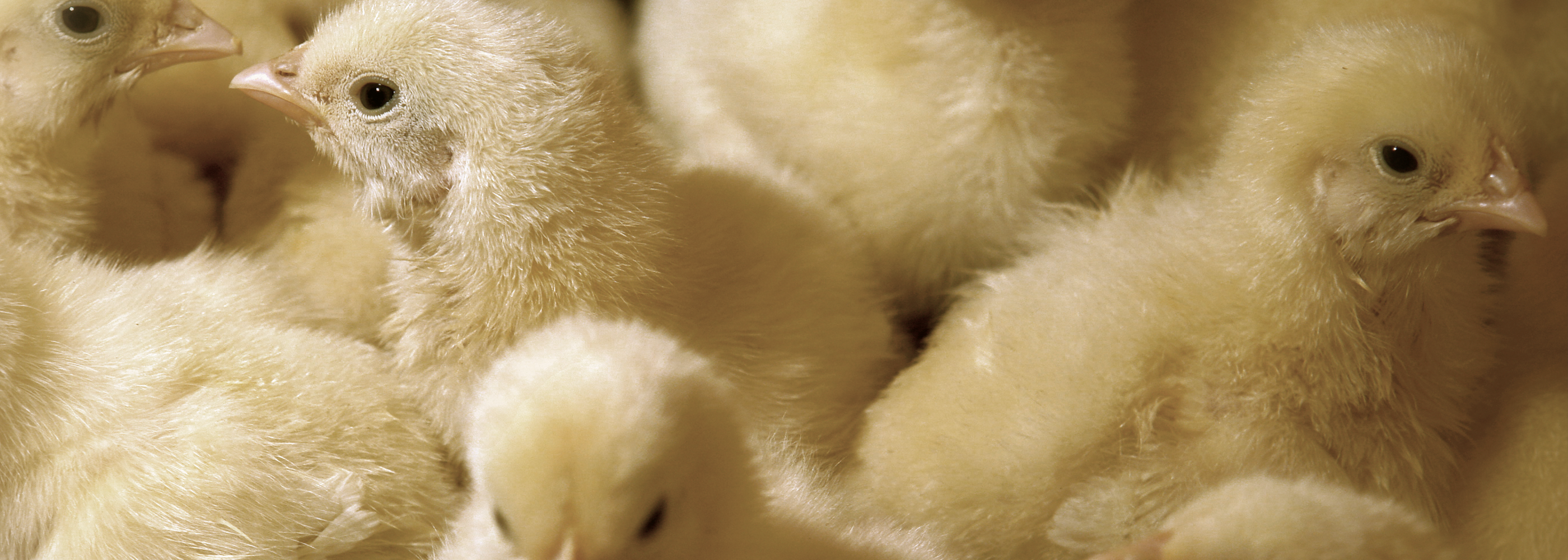The most important time in a chick’s life
Right after hatching, chicks rely on their yolk sac while they learn to scratch for food. When their starter feed contains HP AviStart, they can digest essential nutrients from day 1. That way the yolk sac can be used to develop their immune system – making them stronger and healthier.
University and farm trials have shown that seven days of feed supplementation with HP AviStart optimizes the chicks’ genetic potential for growth over their lifetime.

An efficient feed gives maximum returns
Feed is the critical factor in animal production, accounting for up to 70% of total costs. Using HAMLET PROTEIN specialty soy proteins in young animal feed, you can optimize feed efficiency – and maximize your return on investment.
The key is their easy absorption by immature guts. Although added to feed for only a limited period in early life, our proteins have a strong carry-over effect on animal growth and performance. Feeding trials have documented a higher slaughter weight compared to animals fed standard soybean meal.


Low in anti-nutritional factors
“Gut health” has become a popular expression in the poultry science and production. But what does “Gut Health” actually mean? Gut health is a condition of homeostasis in the gastro-intestinal tract, with respect to its overall structure and function. In this sense, the quality of the feed ingredients definitely plays a crucial role.
Soybean meal (SBM), the most widely used protein source in poultry production, contains various anti-nutritional factors (ANF) that may affect intestinal homeostasis. The main anti-nutritional factors in SBM are trypsin inhibitors (TI), indigestible oligosaccharides, and β-conglycinin. Starter diets including high levels of SBM contain proportionally higher anti-nutritional factors and may indeed pose the risk of impaired gut health.
The elevated variability of the ANF content in SBM and its potential negative impact on gut health and performance highlights the importance of reducing SBM in starter feeds by replacing part of it with low ANF-content protein sources, such as Hamlet Protein poultry products.

Better gut health with reduced need for antibiotics
The ban or rejection of the use of antibiotic growth promoters (AGP) in poultry feed in many countries as well as the increasing restrictions on the use of antibiotics therapeutically are leading to a new paradigm in poultry production. The absence of antibiotics in the feed indeed exposes underlying intestinal problems not necessarily related to infections but to inflammatory responses to dietary factors.
Nowadays, there are numerous feed additives developed with the aim of replacing AGP and antibiotics. However, even with the multitude of imaginable additive mixtures, the quality of the feed ingredients undoubtedly plays a star role in AGP- and antibiotic-free production systems. In this regard, SBM ANF may be the origin of intestinal issues in chickens, reducing their performance. This is particularly critical when it comes to antibiotic-free diets and coccidiosis vaccination.
Hamlet Protein has carried out research with chickens where it has been shown that the addition of enzymatically treated soy protein in starter feed of coccidiosis-vaccinated chicks, with or without AGP throughout the production cycle, equals the weight of the birds infected with Clostridium perfringens and their FCR to that of uninfected chickens. Thus, regardless of the additives we use, the reduction of soy ANF in the starter feed becomes even more necessary when we no longer have antibiotics or coccidiostats.

Improved return on investment
Chicks develop and grow at an incredible rate during the first two week of life. Thus, the increasingly short broiler production cycles make the right choice of ingredients for the (pre) starter feed particularly important. In young chicks, both the digestive tract and immune system are highly immature and therefore susceptible to being harmed by high intake of suboptimal dietary ingredients for that age. So, unless the (pre) starter feed has a low content of anti-nutritional factors, the development of intestinal function and the immune system and, consequently, the growth throughout the life of the bird can be seriously compromised.
Compared to standard SBM, Hamlet Protein poultry products contain a very low level of ANF. That means that the immature guts of young chicks can easily develop much better with this type of clean soy protein in the (pre) starter feed. Hamlet Protein products continue to have a beneficial effect way beyond the starter phase. Such a positive “carry-over effect” has been observed in many trials with broiler chickens in different locations.
The meta-analysis of all the above mentioned trials has corroborated a significant improvement of the chicken performance when birds were fed with enzyme-treated soy protein from Hamlet Protein during the (pre) starter phase. According to this meta-analysis, the weight gain at the slaughter age improves between 0.5 and 2.3%, while FCR improves between 1.8 and 3.1% (90% confidence intervals). These statistically significant performance improvements lead to ROIs equal to or greater than 3: 1 at the end of the production cycle. The inclusion of Hamlet Protein in your (pre) starter feed is definitely a safe and profitable investment.

Reduction in footpad dermatitis
Footpad dermatitis (FPD) is one of the most frequent problems that occur in broiler chicken farms today. It is characterized by lesions on the feet of poultry, which can vary in size and severity. There are a number of reasons that can influence whether or not birds show incidence of FPD. The main single factor is the corrosive effect of wet or damp litter resulting from high amounts of liquid faeces. Therefore, besides water provision, stocking density, climatic conditions and ventilation, feed ingredients play an important role in the triggering of FPD.
Typical SBM contains 4.5-10% indigestible galacto-oligosaccharides (maily raffinose and stachyose), which are unable to be digested by birds, Thus, soy oligosaccharides pass through the small intestine undigested and increase passage rate and luminal fluid retention. So, such indigestible carbohydrates exert an osmotic effect in the gastrointestinal tract until they are fermented. However, the fermentation capacity in the chicken intestine is limited and, consequently, part of these oligosaccharides is not fermented, triggering the above mentioned osmotic effect. The higher osmotic effect makes the digesta watery, which reduces its transit time in the gastrointestinal tract of the chicken, increasing the excretion of liquid feces and the humidity of the litter, clearly FPD predisposing factors.
A series of trials conducted by Hamlet Protein in several feeding regimes, all replacing some SBM with enzyme-treated protein (with an extremely low oligosaccharide content) have shown that Hamlet Protein offers a reliable option for reduction of footpad dermatitis incidence and severity.
Read more details about the trial by clicking below.



Alfred Blanch
Specialty Nutrition Poultry
PHONE NUMBER
+34 678 600 795

